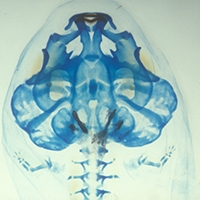Citation:
| 1.74 MB |
Abstract:
The timing and pattern of cranial neural crest cell emergence and migration in the Mexican axolotl, Ambystoma mexicanum, are assessed using scanning electron microscopy (SEM). Cranial neural crest cells emerge and begin to migrate at the time of neural fold closure and soon form three distinct streams. The most anterior (mandibular) stream emerges first, at the level of the mesencephalon. Cells in this stream migrate rostroventrally around the optic vesicle. The second (hyoid) and third (branchial) streams emerge in close succession at the level of the rhombencephalon and extend ventrolaterally. Cells forming the hyoid stream migrate rostral to the otic vesicle, whereas the branchial stream divides into two parallel streams, which migrate caudal to the otic vesicle. At later stages (stage 26 onwards) the cranial neural crest cells disperse into the adjacent mesoderm and can no longer be followed by dissection and SEM. The pattern of cranial neural crest emergence and migration, and division into migratory streams is similar to that in other amphibians and in the Australian lungfish (Neoceratodus forsteri). Emergence of crest cells from the neural tube, relative to the time of neural tube closure, occurs relatively late in comparison to anurans, but much earlier than in the Australian lungfish. These results establish a morphological foundation for studies in progress on the further development and fate of cranial neural crest cells in the Mexican axolotl, as well as for studies of the role of cranial neural crest in cranial patterning.
Notes:
608UJTimes Cited:11Cited References Count:31






